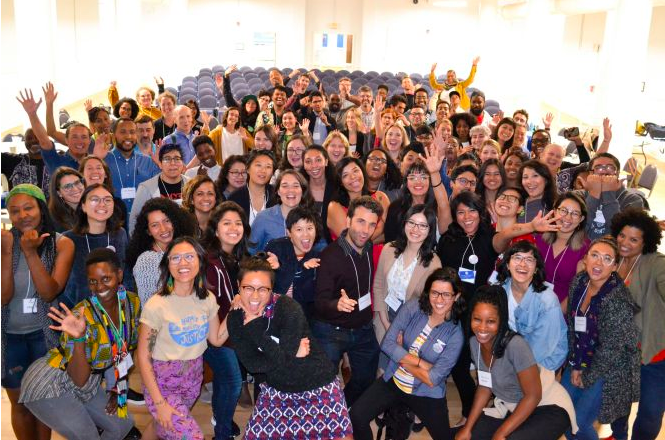This past weekend, I co-facilitated a session at the fourth annual Untokening convening in Durham, North Carolina, alongside Adonia Lugo, one of Untokening's founders and editors of the mobility justice principles; Paola Castañeda, a PhD student at Oxford University researching mobility and urban cycling, particularly in Latin America; and Alejandro Manga Tinoco, a PhD student focusing on alternative mobilities and mobility justice.
Paola has been spearheading translating the Untokening's Principles of Mobility Justice document into (Castellano) Spanish and this session at the Untokening was meant to start gathering feedback for this translation.
The principles of mobility justice were drafted using perspectives gathered at the first Untokening convening in Atlanta, Georgia in 2016. These principles are meant to outline recommendations for mobility justice that are rooted in the liberation of historically marginalized communities. The principles have been a valuable reference tool for me in making sure core issues such as housing displacement, policing, and safety are addressed when we think about new transportation infrastructure or mobility forms.
Joined by Adonia and Paola via Zoom video, we had an intimate conversation with a few other Untokening attendees. The discussion turned into a fruitful conversation about what mobility justice is, which was the central question for me throughout the convening. Before we even translate the direct words, the core part goal is coming to an understanding of what the concept in itself means for communities.
As a mobility justice strategist and one of the authors of the principles of mobility justice, Adonia’s insight was particularly helpful for me in grounding the conversation. She offered some context for developing the principles, which were modeled off of principles of environmental justice.
Adonia described mobility justice as being the umbrella term “to address how street safety goes beyond car-based violence.” Mobility justice is about acknowledging gender-based harassment and violence on the streets, the fear immigrants may feel existing on the street, economic insecurity, criminalization of black and brown people, and so many nuances based on the lived experiences of marginalized residents. Another core aspect of mobility justice is thinking about the ways people feel safe or unsafe while traveling on the street. How do we go beyond talking about bike lanes to address so many other core parts of how people experience the streets as they navigate their lives? These answers need to be developed locally.
One of the critical aspects of interpreting and translating the mobility justice principles goes back to drawing from experiences in the spaces we are trying to reach. Adonia appropriately pointed out, “A bike lane doesn’t mean the same thing in Los Angeles as Santiago.” The Spanish language is one connector, but there are many other geographic differences that make this particular undertaking challenging. “How do you translate the principles of mobility justice to a Latin American context?” Paola asked.
We didn’t come up with conclusive answers during the session, but it opened up the space for us to critically think about mobility justice as a concept and how we want to unravel it in translating the principles to Spanish.
I continued to navigate the day trying to draw from different people’s perspectives and experiences to bring nuance to the term in my mind. In one session, a participant noted that conversations about mobility justice can’t happen without considering design. Hearing these nuanced takes on the term helps us to conceptualize it in a way that can capture more experiences.
I particularly appreciated hearing Jesi Harris of People for Mobility Justice in Los Angeles close out our day with her framing of mobility justice. Jesi reiterated the point that addressing systemic issues goes beyond putting bike lanes in our communities. Tying it to our earlier conversation about translation, Jesi said breaking language barriers is a part of mobility justice. As we build bridges for us to do this work, it’s important to recognize the existing barriers. Mobility justice at its core for me is about pushing back against the barriers that exist for justice on our streets by creating new language for us to relate to as we discuss these issues.
Mobility justice as a term has been important and inspiring for me, affirming why I belong in this work. It’s never been just about buses or bikes; it's about the freedom of movement. I became involved in this work through my anti-displacement housing work around transit-oriented development and The 606 trail. It has never just been about the sole issue of transportation.
As the daughter of Mexican immigrants, the theme of movement and mobility has been a central part of my family’s story. Exploring mobility justice for me is about expanding freedom for people to be able to move and live their lives joyfully and fearlessly. It means making sure immigrants feel safe driving their car or riding a bike on the road. It means prioritizing bus service in our cities. It means expanding rail service to underserved communities. It means centering the voices of those often left out of infrastructure decisions. It means creating policies so low-income residents have stable housing near transit. Mobility justice is a vision for a world rooted in social justice where people feel safe existing on the streets and can build lives experiencing the full joy of movement regardless of their physical ability. Mobility justice is a vision that can guide us to create communities that are truly inclusive and transformative.





